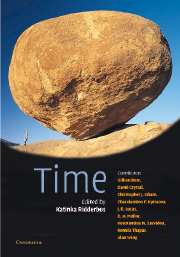4 - The Genetics of Time
Published online by Cambridge University Press: 21 October 2009
Summary
Introduction
I expect that, for most readers, the title of this chapter would at first glance seem a little curious. Perhaps it is a misprint, and ‘physics’ should replace ‘genetics’? Most people would correctly consider the scientific study of time to lie more in the domains of theoretical physics and mathematics. These aspects will be covered in other chapters, but here the biology of time, and particularly the question of how time is encoded within the genome of an organism, will take centre stage.
Biological time, be it for a bacterium, a plant, a fruitfly or a human, is represented by any temporally defined activity. For example, circadian time (Latin: circa = about, dies = day), the major subject of this discussion, is the 24 hour cycle of behaviour and physiology that percolates through the very essence of almost every higher organism that lives on this planet. However, there are many other time scales, both longer and shorter than 24 hours, that have biological significance. Moving up the scale, the ovulation cycles in human females show a monthly rhythm. Our larger domesticated mammals show annual cycles of reproduction that are closely tied to the number of daylight hours, or photoperiod. There are also well-known examples of rhythms that span several years, for example some insect pests show six to seven year swarming cycles.
- Type
- Chapter
- Information
- Time , pp. 65 - 84Publisher: Cambridge University PressPrint publication year: 2002
- 1
- Cited by



